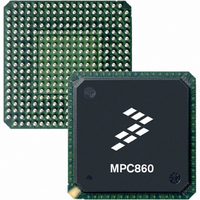MC68MH360ZP25VL Freescale Semiconductor, MC68MH360ZP25VL Datasheet - Page 144

MC68MH360ZP25VL
Manufacturer Part Number
MC68MH360ZP25VL
Description
IC MPU QUICC ETHER 25MHZ 357PBGA
Manufacturer
Freescale Semiconductor
Datasheet
1.MC68MH360VR25LR2.pdf
(158 pages)
Specifications of MC68MH360ZP25VL
Processor Type
M683xx 32-Bit
Speed
25MHz
Voltage
3.3V
Mounting Type
Surface Mount
Package / Case
357-PBGA
Lead Free Status / RoHS Status
Contains lead / RoHS non-compliant
Features
-
Available stocks
Company
Part Number
Manufacturer
Quantity
Price
Company:
Part Number:
MC68MH360ZP25VL
Manufacturer:
Freescale Semiconductor
Quantity:
10 000
- Current page: 144 of 158
- Download datasheet (5Mb)
Freescale Semiconductor, Inc.
C.3.1.1 Activation Procedure
If no S/T transceiver is active, no TCLK clock is generated. Once the first transceiver is
activated, it will generate a TCLK signal only if DCL and FSC signals are present as well.
Pseudo DCL and FSC signals generated from one of the baud rate generators (BRG) of the
QUICC32 can be used to generate the TCLK signal. The BRG can generate a clock based
on the QUICC32’s system clock. A divider factor should be chosen so that the BRG
frequency is close to 2.048 MHz. This clock then feeds into the 256-divider circuitry of
Figure C-4 to generate a pseudo DCL and a pseudo FSC.
A multiplexer commanded by the QUICC32 is required to select either the BRG signal or
the TCLK signals of the transceivers to be the clock master generating the DCL and FSC
signals.
When no transceiver is activated, the QUICC32 selects the BRG to be the clock master, and
the S/T interface receives the pseudo DCL and FSC signals. (These two signals are not
synchronized to the network but are not used to sample data.)
As the first MC145574 is activated, it will be able to generate the TCLK signal; see
Figure C-7. This transceiver will then send an interrupt to the QUICC32 (IRQ3—register
NR3[3]—meaning Info 2 has been received) indicating that the activation process has
begun. The QUICC32 then uses the multiplexer to select the TCLK signal of that
MC145574 to be the clock master.
As shown in Figure C-7 and Figure C-8, the TCLK signal is present before the interruption,
with at least 750 s between the IRQ and the received Info 4. The QUICC32 therefore has
750 s to react to the IRQ and to select the new clock master.
QMC Supplement
For More Information On This Product,
Go to: www.freescale.com
Related parts for MC68MH360ZP25VL
Image
Part Number
Description
Manufacturer
Datasheet
Request
R
Part Number:
Description:
Manufacturer:
Freescale Semiconductor, Inc
Datasheet:
Part Number:
Description:
Manufacturer:
Freescale Semiconductor, Inc
Datasheet:
Part Number:
Description:
Manufacturer:
Freescale Semiconductor, Inc
Datasheet:
Part Number:
Description:
Manufacturer:
Freescale Semiconductor, Inc
Datasheet:
Part Number:
Description:
Manufacturer:
Freescale Semiconductor, Inc
Datasheet:
Part Number:
Description:
Manufacturer:
Freescale Semiconductor, Inc
Datasheet:
Part Number:
Description:
Manufacturer:
Freescale Semiconductor, Inc
Datasheet:
Part Number:
Description:
Manufacturer:
Freescale Semiconductor, Inc
Datasheet:
Part Number:
Description:
Manufacturer:
Freescale Semiconductor, Inc
Datasheet:
Part Number:
Description:
Manufacturer:
Freescale Semiconductor, Inc
Datasheet:
Part Number:
Description:
Manufacturer:
Freescale Semiconductor, Inc
Datasheet:
Part Number:
Description:
Manufacturer:
Freescale Semiconductor, Inc
Datasheet:
Part Number:
Description:
Manufacturer:
Freescale Semiconductor, Inc
Datasheet:
Part Number:
Description:
Manufacturer:
Freescale Semiconductor, Inc
Datasheet:
Part Number:
Description:
Manufacturer:
Freescale Semiconductor, Inc
Datasheet:











